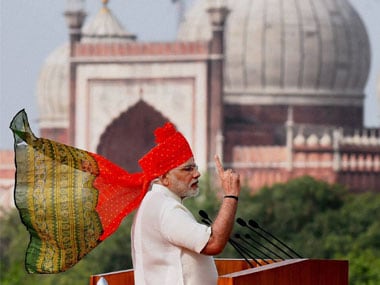He has been called India’s Margaret Thatcher, the British PM who shook up an arthritic economy out of statist somnolence. He has been likened to Ronald Reagan, the amiable, business-friendly, tax-cutting Republican President of the US, also of the 1980s. He has even been compared to Lee Kuan Yew, that incorruptible Singaporean Prime Minister who reinvented that city-state in the 1960s and ruled till 1990. But Charles de Gaulle, that fiercely nationalist President of the French Fifth Republic from 1959 to 1969? Is Narendra Modi more de Gaulle than Reagan, Thatcher or Lee? [caption id=“attachment_1667203” align=“alignleft” width=“380”]  PM Narendra Modi delivers his Independence Day speech. PTI[/caption] If you were to ask Pratap Bhanu Mehta, President of Delhi’s Centre for Policy Research, the answer would be yes. He thinks of Modi as a Republican Monarch. Reacting to Modi’s strong Independence Day speech, Mehta wrote in The Indian Express today (16 August): “De Gaulle was described by one biographer, Jonathan Fenby, as a republican monarch. This phrase… was meant to capture something distinctive about the nature of de Gaulle’s democratic engagement: his unique ability to both wield authority and yet personify the people. Modi’s engagement has a similar quality.” Given his risen-from-the-ranks image and his earthy ability to connect with the aspirations of ordinary people even while centralising a lot of political power in his own office, Modi is certainly a republican monarch of sorts. Mehta contrasts Modi’s authority against that of his pedigreed predecessors, who got it from lineage, caste or class (the Gandhi dynasty, or even the Brahmin Atal Behari Vajpayee, for example). Like any monarch, Modi’s power and authority come with serious limitations, but Mehta is clear that his power comes directly from the people. He writes: “Modi carries the imprimatur of authority because it was animated by a confident sense that he embodied the nation whose first servant he had declared himself to be. It has the confidence only self-made men can have. It is democratic in the sense of being direct: its extempore quality refusing a script as itself being an intolerable form of mediation between the people and its leaders.” Only a person confident in his own skin can talk about toilets and sanitation in such detail on an occasion meant to celebrate India’s independency day — a day usually reserved for chest-thumping and flag-waving. He waved a toilet mug and got away with it. Modi’s confident demeanour was apparent from his brisk and energetic walk to the Red Fort podium, from the way he talked without a script, and from his strong hand gestures on I-Day. Every motion of his hands and fingers lent weight to what he said. This was in strong contrast to the wooden speech he made to the BRICS summit in Brazil in July. Clearly, Modi connects only when he is himself, in his Indian avatar, talking in Hindi, or in his native Gujarati. The comparison with de Gaulle is apt for the simple reason that both he and Modi were strongly nationalistic, believers in their nation’s destinies and internal cultural strengths. Hence the abandonment of the closing ‘Jai Hind’ in favour of ‘Vande Mataram’. Critics will see this as another pandering to Hindutva, but it is more likely that this is him. He does not believe in trying to be “secular” just to please the Delhi media. In public, Modi wears his Indian-ness on his sleeve, even if that sleeve is tailored by experts with a fine sense of taste. His sartorial advisors clearly plan their flourishes for each occasion – one for his swearing in, one for his I-Day speech, complete with a Jodhpuri turban that shone in a resplendent bright orange-red hue. In his attention to detail he surely is less Indian than we imagine. He is more western, or even more eastern (like the Chinese or the Japanese, who like precision in what they are dealing with), but certainly not fully Indian. One of the major Indian failings is to talk in generalities without being specific; to talk about vision without implementation, to talk animatedly about an issue and then quickly forget all about it. We don’t usually follow up on our promises. We also criticise even if we have nothing useful to contribute. This was reflected in political criticism of Modi’s speech, with the Congress party calling it “pedestrian.” Hear spokesman Manish Tewari on this: “Given that it was the first address of the new PM, one expected (a) certain vision to be articulated by him on the trajectory of the next five years. But it is unfortunate that PM got bogged down by pedestrian issues without being able to rise to the occasion.” This is bunkum, for Modi has been outlining his vision of poverty elimination, cleanliness, homes for all, a business-friendly environment, and a boost to Indian manufacturing, among other things. Others have had these visions too, but it is probably Modi who is more likely to get into the nitty-gritty of how to redirect vision towards reality. Hopefully, Modi is not among those who mistake vision for action and implementation.
Is Narendra Modi more Charles de Gaulle than Thatcher or Reagan? One thing is certain: he derives his authority directly from the people, and in this he is more closely linked to the aam aadmi that any of our previous prime ministers
Advertisement
End of Article
Written by R Jagannathan
R Jagannathan is the Editor-in-Chief of Firstpost. see more


)
)
)
)
)
)
)
)
)



